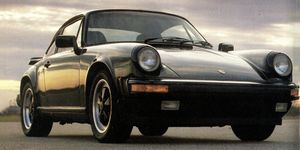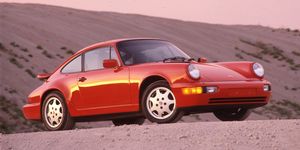View Photos

Michael SimariCar and Driver
This is very likely the least expensive new Porsche 911 you’ll ever lay eyes on. At $106,290, it has a mere $7540 in options, which, if you don’t believe is a picture of restraint, go spend a few minutes on Porsche’s online configurator. This car had just four add-ons: a Sport Exhaust system ($2950); the Sport Chrono package, which includes launch control ($2720); Lane Change Assist, which most other automakers call blind-spot detection ($1060); and Sport Seats Plus ($810). Let’s see if the extreme low end of the 911 lineup lives up to six-figure sports-car expectations.
A peak horsepower figure of only 379 from its twin-turbo 3.0-liter flat-six is not a great start toward credibility. A V-6 Camry also has a power figure that starts with a 3 yet costs a third as much, and there are many examples of more for less when it comes to maximizing underhood output.
But the 911 is deceptive. In the new-for-2020 992-generation 911, an eight-speed dual-clutch automatic transmission—PDK in Porsche parlance—replaces the previous seven-speed unit. Its general brilliance in terms of both quickness and smoothness is familiar, although the car we drove did bobble a couple of shifts before it was fully up to temperature. Also familiar is Porsche’s simple and extremely effective launch-control function, which revs the engine to 5000 rpm before dropping the hammer and perfectly slipping the clutch. The engine’s rpms never drop below 4000 as the car makes a smooth and very swift departure. And it is happy to repeat this launch-toward-the-horizon routine just as often as you’d like. Although we weren’t able to test this car, we’re confident that the base 911 will hit 60 mph in 3.2 seconds and fly through the quarter-mile in 11.5 seconds, which should make it 0.1- and 0.3-second quicker, respectively, than the 2017 911 Carrera with the PDK that we previously tested. Those estimates also would make the base car 0.3-second slower than the 443-hp Carrera S in both measures.
Besides the phenomenal performance bargain that is the latest Chevrolet Corvette, any sports car that outruns the 911 costs substantially more. One reason for its more-with-less performance is that the 911 has kept its weight gain in better check than many of its peers. This car weighs just 46 pounds more than before, making it roughly 300 pounds lighter than today’s Corvette. Despite adding inches and turbos, the 911 doesn’t weigh even 100 pounds more than the 15-year-old 997-generation cars.
Excellent Fundamentals
In addition to straight-line acceleration, the fundamentals of a great sports car are all here. The 911’s buildup in steering effort is just right, and it’s constantly atwitter with road-surface information. This is electrically assisted steering done properly. Interestingly, the lid of the center console bin is surprisingly talkative, too. Resting an elbow there intercepts the communicatory tingles of what the car happens to be trampling over at the moment. The 911 also continues to prove the point that seats don’t need a lot of adjustments. The headrest is fixed, and there’s manual fore-aft, and power adjustment for height and seatback angle and bottom height. That’s it, and yet they fit both the short and the tall commendably well. The additional bolstering of the $810 Sport Seats Plus option is soft enough to not be restrictive nor fatiguing on longer drives. Brake feel is nigh on perfect, with telepathic responses and no lost motion.
We appreciate that changing the 911’s drive mode doesn’t cause the steering effort or ride control to go overboard in either direction. The tweaks in its calibrations are subtle, and there isn’t a bad mode. The only element that makes us roll our eyes is the three artificial-sounding pops that accompany a lift of the throttle in Sport mode, which disappear in Sport Plus. Both sporty modes raise the idle speed from 600 to 800 rpm for a little extra responsiveness. Those who listen for it can hear the turbo hiss from the blow-off valve, but this latest twin-turbo 3.0-liter retains the gritty flat-six undertones that we love, no doubt emboldened by the optional Sport Exhaust on our car. Every 911 has a little piece of the 9000-rpm GT3 rock.
As far as sports cars go, the 911’s ride smoothness is reasonable. But on under-maintained roads, it can get clompy over bumps and pavement seams, especially with the narrower sidewall and higher-pressure rear tires. Remember that the 992 went to a staggered-diameter wheel arrangement with 19-inch fronts and 20-inch rears as standard and available 20/21s.
When not wailing, the engine settles below 1800 rpm at 75 mph, allowing for fuel economy approaching 30 mpg, about the same as before. However, the EPA values took a huge hit in the 992 generation, dropping from a 30-mpg highway estimate to 24 for a base car with the automatic transmission.
Entry-Level Innards
Base also means a uniformly grained black interior, which, although soft to the touch, is not as convincing in the six-figure space as are the leather-upgrade options that start at $2840. The only thing breaking up the monotony is the knurled gray trim extending from the door handle and on the ridge under the center screen running across the dash.
Surrounding the shifter is a large area of stark piano-black trim, which no amount of money can fix, as even the $204,850 Turbo S doesn’t fill in any of its blankness. This is a carryover from the four-door Panamera, which populates this area with controls. There are window-switch blanks, too, as Porsche is deploying shared hardware across car lines with different door counts. A big, beautiful mechanical tachometer remains in the middle of the 911’s now otherwise digital gauge cluster. But we miss the depth of the previous mechanical gauges that flanked it.
Also new on the 992 are power door handles that pop out to facilitate opening. They don’t do so automatically, however, unless you pay for the $550 Comfort Access option. So, on cars like ours, getting them to extend requires pushing the unlock button on the key fob. Then you can put that fob back in your pocket, because keyless ignition is standard. While seemingly slight, this is an annoyance that we think the kind of people who plunk down $100K on a car will find obnoxious.
Of course, the 911 retains its familiar small rear seats, an all-important point of justification to wannabe sports-car buyers with small children. That means in addition to outperforming and outdriving most of its peers, it also outseats them. Yes, even the base 911 resoundingly stacks up as a six-figure sports car. Although we would feel compelled to upgrade the interior a little if it were our money.
Source: Reviews - aranddriver.com














